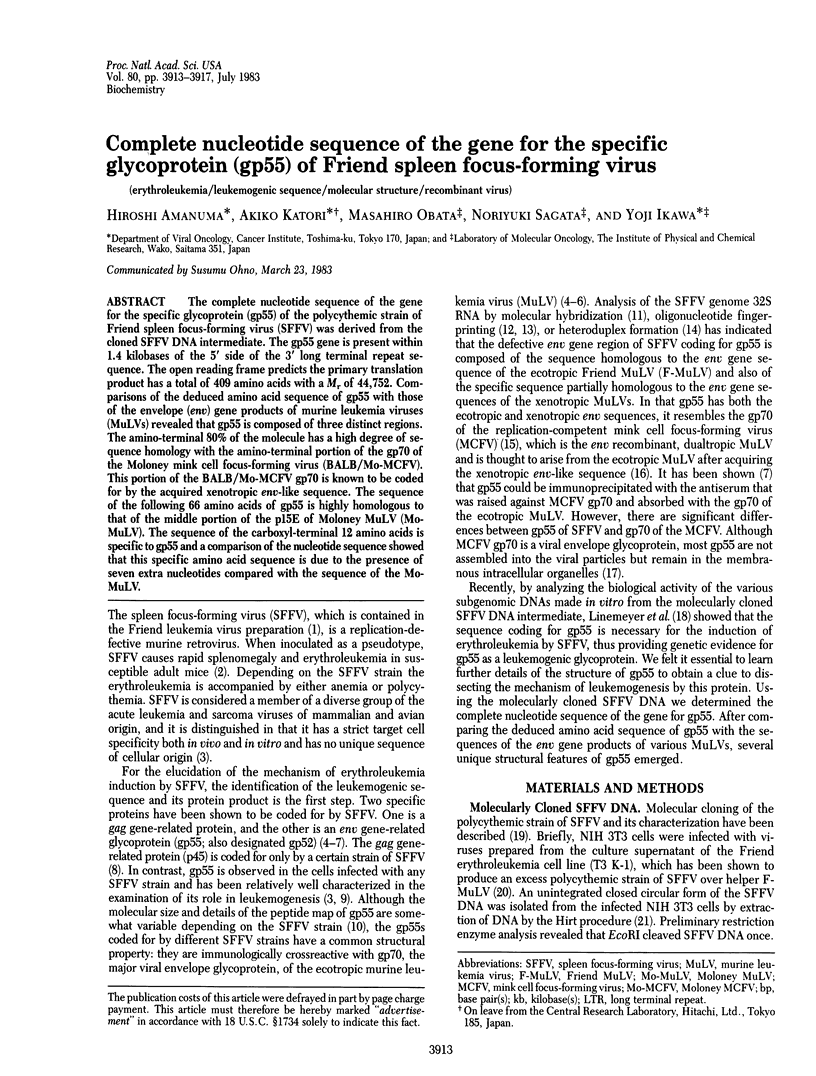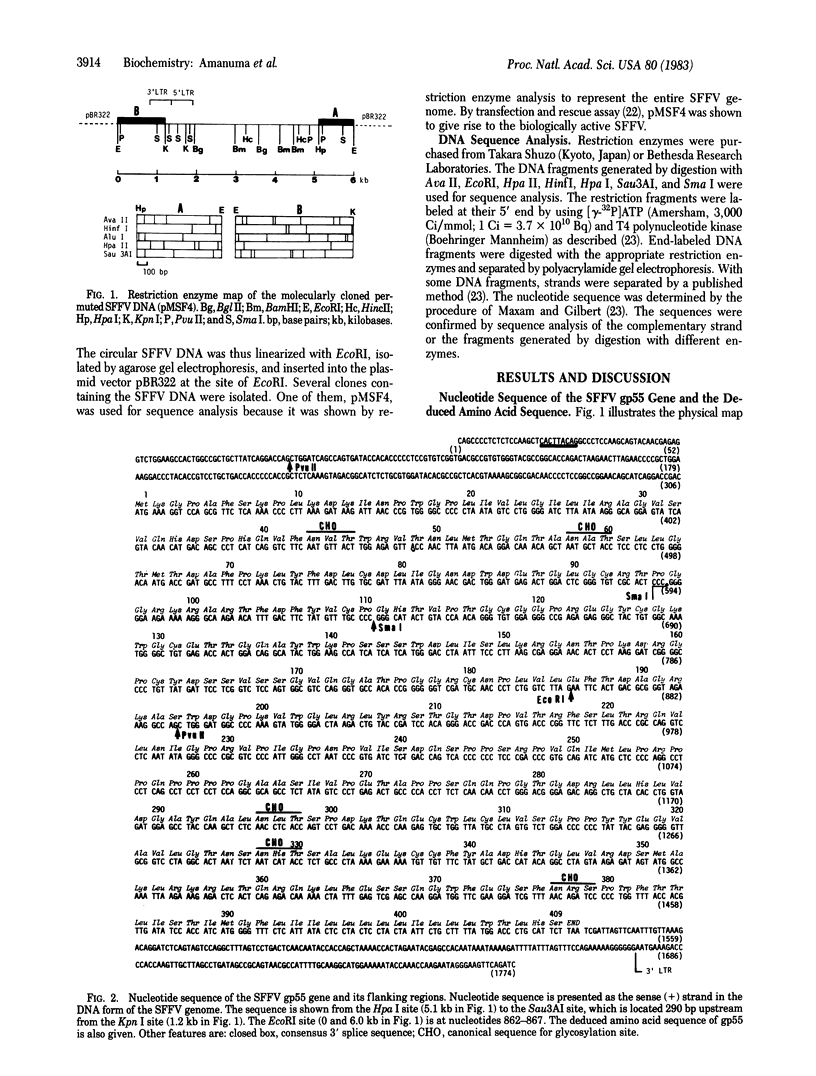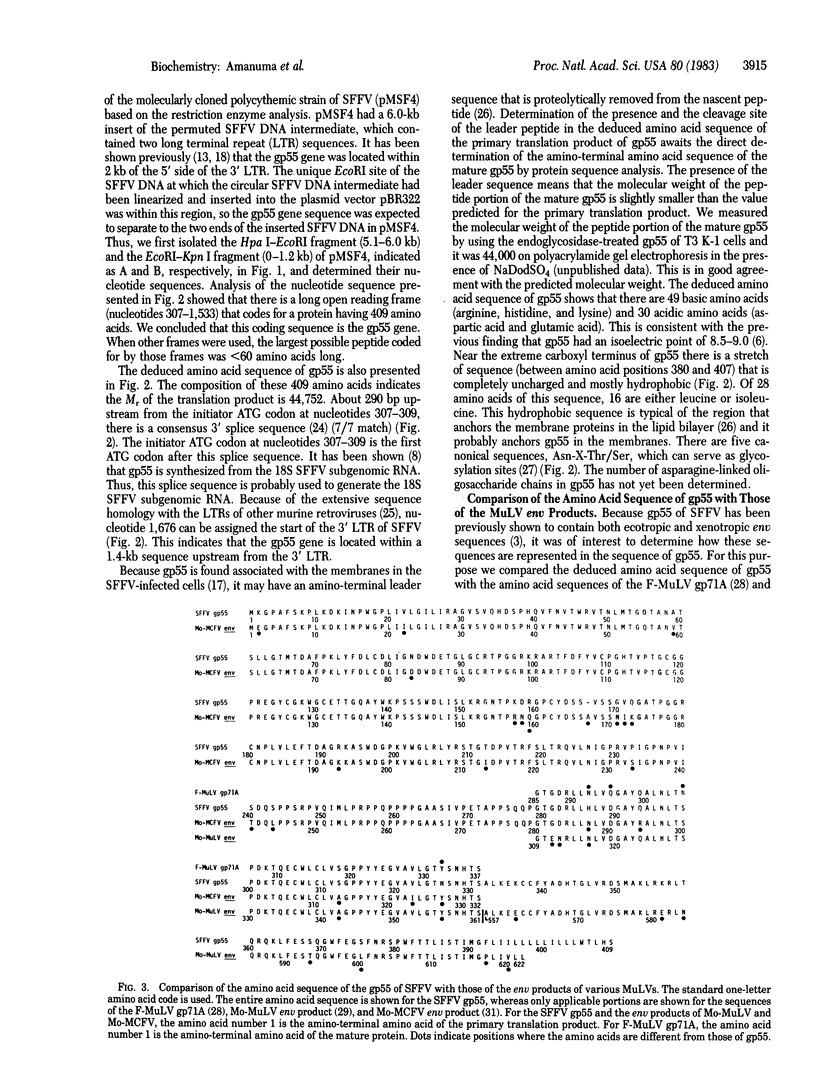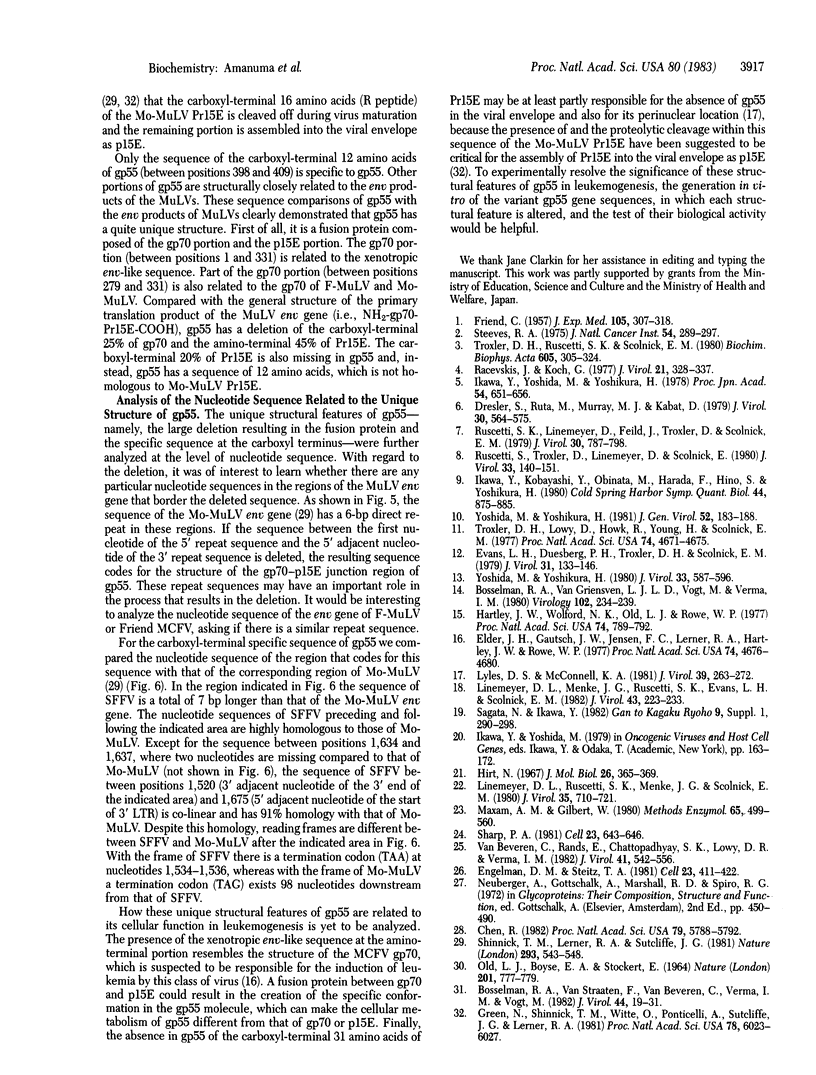Abstract
The complete nucleotide sequence of the gene for the specific glycoprotein (gp55) of the polycythemic strain of Friend spleen focus-forming virus (SFFV) was derived from the cloned SFFV DNA intermediate. The gp55 gene is present within 1.4 kilobases of the 5' side of the 3'long terminal repeat sequence. The open reading frame predicts the primary translation product has a total of 409 amino acids with a Mr of 44,752. Comparisons of the deduced amino acid sequence of gp55 with those of the envelope (env) gene products of murine leukemia viruses (MuLVs) revealed that gp55 is composed of three distinct regions. The amino-terminal 80% of the molecule has a high degree of sequence homology with the amino-terminal portion of the gp70 of the Moloney mink cell focus-forming virus (BALB/Mo-MCFV). This portion of the BALB/Mo-MCFV gp70 is known to be coded for by the acquired xenotropic env-like sequence. The sequence of the following 66 amino acids of gp55 is highly homologous to that of the middle portion of the p15E of Moloney MuLV (Mo-MuLV). The sequence of the Carboxyl-terminal 12 amino acids is specific to gp55 and a comparison of the nucleotide sequence showed that this specific amino acid sequence is due to the presence of seven extra nucleotides compared with the sequence of the Mo-MuLV.
Full text
PDF




Selected References
These references are in PubMed. This may not be the complete list of references from this article.
- Bosselman R. A., Van Griensven L. J., Vogt M., Verma I. M. Genome organization of retroviruses IX. Analysis of the genomes of Friend spleen focus-forming (F-SFFV) and helper murine leukemia viruses by heteroduplex-formation. Virology. 1980 Apr 15;102(1):234–239. doi: 10.1016/0042-6822(80)90088-4. [DOI] [PubMed] [Google Scholar]
- Bosselman R. A., van Straaten F., Van Beveren C., Verma I. M., Vogt M. Analysis of the env gene of a molecularly cloned and biologically active Moloney mink cell focus-forming proviral DNA. J Virol. 1982 Oct;44(1):19–31. doi: 10.1128/jvi.44.1.19-31.1982. [DOI] [PMC free article] [PubMed] [Google Scholar]
- Chen R. Complete amino acid sequence and glycosylation sites of glycoprotein gp71A of Friend murine leukemia virus. Proc Natl Acad Sci U S A. 1982 Oct;79(19):5788–5792. doi: 10.1073/pnas.79.19.5788. [DOI] [PMC free article] [PubMed] [Google Scholar]
- Dresler S., Ruta M., Murray M. J., Kabat D. Glycoprotein encoded by the Friend spleen focus-forming virus. J Virol. 1979 May;30(2):564–575. doi: 10.1128/jvi.30.2.564-575.1979. [DOI] [PMC free article] [PubMed] [Google Scholar]
- Elder J. H., Gautsch J. W., Jensen F. C., Lerner R. A., Hartley J. W., Rowe W. P. Biochemical evidence that MCF murine leukemia viruses are envelope (env) gene recombinants. Proc Natl Acad Sci U S A. 1977 Oct;74(10):4676–4680. doi: 10.1073/pnas.74.10.4676. [DOI] [PMC free article] [PubMed] [Google Scholar]
- Engelman D. M., Steitz T. A. The spontaneous insertion of proteins into and across membranes: the helical hairpin hypothesis. Cell. 1981 Feb;23(2):411–422. doi: 10.1016/0092-8674(81)90136-7. [DOI] [PubMed] [Google Scholar]
- Evans L. H., Duesberg P. H., Troxler D. H., Scolnick E. M. Spleen focus-forming Friend virus: identification of genomic RNA and its relationship to helper virus RNA. J Virol. 1979 Jul;31(1):133–146. doi: 10.1128/jvi.31.1.133-146.1979. [DOI] [PMC free article] [PubMed] [Google Scholar]
- FRIEND C. Cell-free transmission in adult Swiss mice of a disease having the character of a leukemia. J Exp Med. 1957 Apr 1;105(4):307–318. doi: 10.1084/jem.105.4.307. [DOI] [PMC free article] [PubMed] [Google Scholar]
- Green N., Shinnick T. M., Witte O., Ponticelli A., Sutcliffe J. G., Lerner R. A. Sequence-specific antibodies show that maturation of Moloney leukemia virus envelope polyprotein involves removal of a COOH-terminal peptide. Proc Natl Acad Sci U S A. 1981 Oct;78(10):6023–6027. doi: 10.1073/pnas.78.10.6023. [DOI] [PMC free article] [PubMed] [Google Scholar]
- Hartley J. W., Wolford N. K., Old L. J., Rowe W. P. A new class of murine leukemia virus associated with development of spontaneous lymphomas. Proc Natl Acad Sci U S A. 1977 Feb;74(2):789–792. doi: 10.1073/pnas.74.2.789. [DOI] [PMC free article] [PubMed] [Google Scholar]
- Hirt B. Selective extraction of polyoma DNA from infected mouse cell cultures. J Mol Biol. 1967 Jun 14;26(2):365–369. doi: 10.1016/0022-2836(67)90307-5. [DOI] [PubMed] [Google Scholar]
- Ikawa Y., Kobayashi Y., Obinata M., Harada F., Hino S., Yoshikura H. RNA sequences and proteins specific to Friend strain of spleen focus-forming virus. Cold Spring Harb Symp Quant Biol. 1980;44(Pt 2):875–885. doi: 10.1101/sqb.1980.044.01.094. [DOI] [PubMed] [Google Scholar]
- Linemeyer D. L., Menke J. G., Ruscetti S. K., Evans L. H., Scolnick E. M. Envelope gene sequences which encode the gp52 protein of spleen focus-forming virus are required for the induction of erythroid cell proliferation. J Virol. 1982 Jul;43(1):223–233. doi: 10.1128/jvi.43.1.223-233.1982. [DOI] [PMC free article] [PubMed] [Google Scholar]
- Linemeyer D. L., Ruscetti S. K., Menke J. G., Scolnick E. M. Recovery of biologically active spleen focus-forming virus from molecularly cloned spleen focus-forming virus-pBR322 circular DNA by cotransfection with infectious type C retroviral DNA. J Virol. 1980 Sep;35(3):710–721. doi: 10.1128/jvi.35.3.710-721.1980. [DOI] [PMC free article] [PubMed] [Google Scholar]
- Lyles D. S., McConnell K. A. Subcellular localization of the env-related glycoproteins in Friend erythroleukemia cells. J Virol. 1981 Jul;39(1):263–272. doi: 10.1128/jvi.39.1.263-272.1981. [DOI] [PMC free article] [PubMed] [Google Scholar]
- Maxam A. M., Gilbert W. Sequencing end-labeled DNA with base-specific chemical cleavages. Methods Enzymol. 1980;65(1):499–560. doi: 10.1016/s0076-6879(80)65059-9. [DOI] [PubMed] [Google Scholar]
- OLD L. J., BOYSE E. A., STOCKERT E. TYPING OF MOUSE LEUKAEMIAS BY SEROLOGICAL METHODS. Nature. 1964 Feb 22;201:777–779. doi: 10.1038/201777a0. [DOI] [PubMed] [Google Scholar]
- Racevskis J., Koch G. Viral protein synthesis in Friend erythroleukemia cell lines. J Virol. 1977 Jan;21(1):328–337. doi: 10.1128/jvi.21.1.328-337.1977. [DOI] [PMC free article] [PubMed] [Google Scholar]
- Ruscetti S. K., Linemeyer D., Feild J., Troxler D., Scolnick E. M. Characterization of a protein found in cells infected with the spleen focus-forming virus that shares immunological cross-reactivity with the gp70 found in mink cell focus-inducing virus particles. J Virol. 1979 Jun;30(3):787–798. doi: 10.1128/jvi.30.3.787-798.1979. [DOI] [PMC free article] [PubMed] [Google Scholar]
- Ruscetti S., Troxler D., Linemeyer D., Scolnick E. Three laboratory strains of spleen focus-forming virus: comparison of their genomes and translational products. J Virol. 1980 Jan;33(1):140–151. doi: 10.1128/jvi.33.1.140-151.1980. [DOI] [PMC free article] [PubMed] [Google Scholar]
- Sharp P. A. Speculations on RNA splicing. Cell. 1981 Mar;23(3):643–646. doi: 10.1016/0092-8674(81)90425-6. [DOI] [PubMed] [Google Scholar]
- Shinnick T. M., Lerner R. A., Sutcliffe J. G. Nucleotide sequence of Moloney murine leukaemia virus. Nature. 1981 Oct 15;293(5833):543–548. doi: 10.1038/293543a0. [DOI] [PubMed] [Google Scholar]
- Steeves R. A. Editorial: Spleen focus-forming virus in Friend and Rauscher leukemia virus preparations. J Natl Cancer Inst. 1975 Feb;54(2):289–297. doi: 10.1093/jnci/54.2.289. [DOI] [PubMed] [Google Scholar]
- Troxler D. H., Lowy D., Howk R., Young H., Scolnick E. M. Friend strain of spleen focus-forming virus is a recombinant between ecotropic murine type C virus and the env gene region of xenotropic type C virus. Proc Natl Acad Sci U S A. 1977 Oct;74(10):4671–4675. doi: 10.1073/pnas.74.10.4671. [DOI] [PMC free article] [PubMed] [Google Scholar]
- Troxler D. H., Ruscetti S. K., Scolnick E. M. The molecular biology of Friend virus. Biochim Biophys Acta. 1980 Sep 22;605(3):305–324. doi: 10.1016/0304-419x(80)90014-1. [DOI] [PubMed] [Google Scholar]
- Van Beveren C., Rands E., Chattopadhyay S. K., Lowy D. R., Verma I. M. Long terminal repeat of murine retroviral DNAs: sequence analysis, host-proviral junctions, and preintegration site. J Virol. 1982 Feb;41(2):542–556. doi: 10.1128/jvi.41.2.542-556.1982. [DOI] [PMC free article] [PubMed] [Google Scholar]
- Yoshida M., Yoshikura H. A glycoprotein specified by spleen focus-forming virus in three cell lines varies on molecular size and peptide composition, but retains both xenotropic and ecotropic MuLV antigenicity. J Gen Virol. 1981 Jan;52(Pt 1):183–188. doi: 10.1099/0022-1317-52-1-183. [DOI] [PubMed] [Google Scholar]
- Yoshida M., Yoshikura H. Analysis of spleen focus-forming virus-specific RNA sequences coding for spleen focus-forming virus-specific glycoprotein with a molecular weight of 55,000 (gp55). J Virol. 1980 Feb;33(2):587–596. doi: 10.1128/jvi.33.2.587-596.1980. [DOI] [PMC free article] [PubMed] [Google Scholar]


